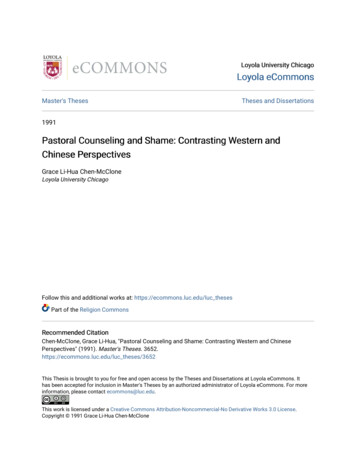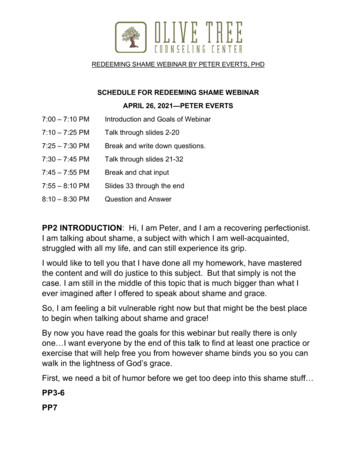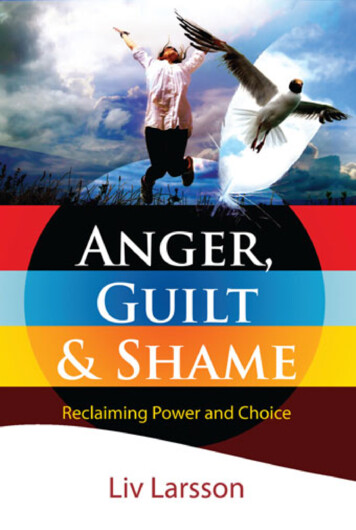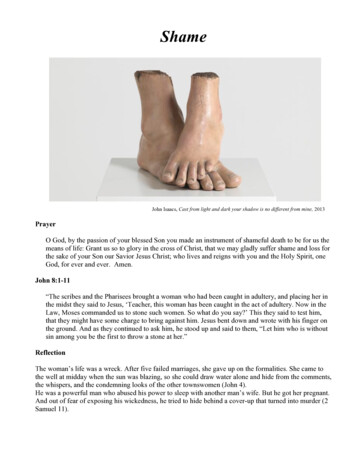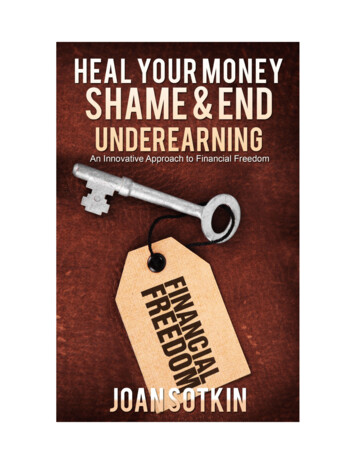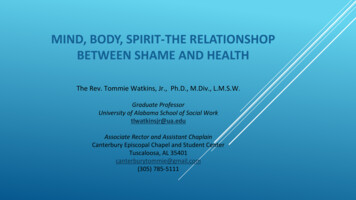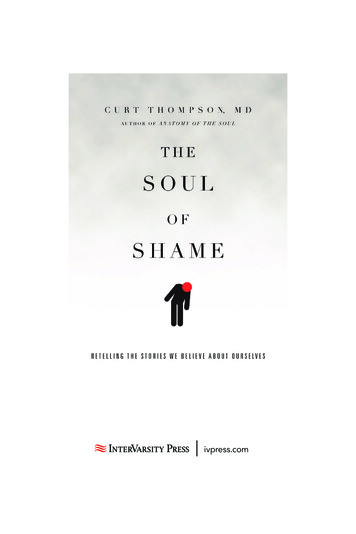
Transcription
Considering Shame and Shame-Sensitive Practicein PolicingLuna Dolezal, University of Exeter
§ James Gilligan, psychiatrist. Quotes from Violence: Reflections on Our DeadliestEpidemic
§ Shame is a powerful experience that shapes behaviour and action.§ Shame is a driver for anti-social behaviour and violence.§ However, the connection between shame and violence is often not recognized orunderstood.§ Chronic shame is common among individuals who have suffered trauma or who livewith stigma or on-going social harms such as poverty, discrimination, socialdeprivation, etc.§ Understanding shame, and the behaviours that arise because of shame responses,can be helpful in guiding prevention and policing practices.§ Deploying shame-sensitive practice in approaches to policing will be effective inensuring more humane practice, helping address and understand some of the rootcauses of anti-social, criminal and violent behaviours.
§ To provide an introduction to shame.§ To provide some basic ‘shame competence’.§ To understand how chronic shame is connected to stigma,social harms and trauma.§ To raise awareness of the links between shame and violence,shame and violent crime, and shame and other criminal andanti-social behaviours.§ To outline some principles of shame-sensitive practice.
§ Shame is a negative self-conscious emotion.§ Shame happens when we are concerned about how we are seenand judged by others, because we feel we are flawed in somecrucial way, or when some part of our core self is perceived to beinadequate, abnormal, inappropriate, or immoral.§ Shame itself is shameful and taboo.§ As a result, shame is often hidden, unspoken, repressed,bypassed, kept secret, or goes ‘underground’, both individually andcollectively.§ Because shame can powerfully shape behaviour, identity andactions it is often called the “master emotion” (Scheff 2004).
§ Shame is an individual emotional experience.§ Shame makes us feel that we are being judged and that we are falling short ofwhat is expected by others, by society, by our culture, or by ourselves.§ When one experiences shame, it often feels as though one is isolated and alsoto blame for the shame.§ However, shame is always connected to social and cultural norms (these arewhat determine what is shameful or otherwise ‘normal’ or ’acceptable’).§ Every individual shame experience is determined by external socialnorms and connects an individual to their society, culture and politicalsphere.§ Hence, shame is always social and political (Dolezal 2015).
§ Shame makes us feel that our social bonds are under threat and that we may berejected, shunned or ostracized.§ As a result, shame is an intensely difficult and threatening experience.§ There are a lot of experiences that can be understood to fall under theumbrella term of “shame”.§ Experiences like losing face, feeling inferior, being subjugated, being disrespected,being mocked, ridiculed, slighted or degraded can be understood as shameexperiences.§ ‘Shame’ also includes related emotions and experiences such as embarrassment,humiliation, mortification, chagrin, self-consciousness, social anxiety, etc.
§ While shame is a negative experience for an individual, it is a normal and necessarypart of human life.§ Healthy shame can lead to the expression of positive characteristics such as modesty,humility and gratitude, along with respect for oneself and for others.§ Healthy shame can also be a powerful motivating force for personal growth andchange, and in forging harmonious and meaningful relationships with others(Sanderson 2015, Ng 2020).§ Healthy shame can help one learn and grow, setting important boundaries for pro-social behaviour and health relationships.
§ However, healthy shame is very easily distorted and canbecome ‘unhealthy’, “maladaptive” or “destructive” (Sanderson2015, 22).§ John Bradshaw notes, “shame as a healthy human emotioncan be transformed into shame as a state of being [which] isto believe that one’s being is flawed, that one is defective as ahuman being. [Shame] becomes toxic and dehumanizing”(Bradshaw 2005, xvii).§ Toxic shame, Sanderson notes, “paradoxically seversconnections, destroys social bonds and can lead to antisocialbehaviour, hostility, rage and violence” (Sanderson 2015, 22).§ Toxic shame is corrosive and extremely damaging. It can leadto a pervasive and enduring sense of inferiority, inadequacy,defectiveness, along with a sense of not being worthy ofrespect, love or connection.Image by Hannah Mumby;https://www.hannahmumby.co.uk
§ Instead of being pro-social and helping maintain connections to others, maladaptive(or toxic) shame can lead to behaviours and actions that are personally and sociallyharmful.§ For example, research demonstrates links between shame and:1.2.3.4.5.6.7.8.9.Violence and violent crimeDomestic abuseSexual violenceAddictionEating DisordersExploitation, including child exploitationSelf harm and suicideTerrorism and radicalizationOffender decision making
§ Maladaptive and toxic shame usually occur in a chronic form.§ Stephen Pattison writes: “There is an enormous difference betweenacute, reactive shame and the chronic shame that shapes a wholepersonality and may last a lifetime. When individuals appear toexperience the whole of life as actually or potentially shame-productiveand manifest such symptoms as withdrawal, self-contempt, inferiorityand gaze aversion as a matter of course throughout their everydaylives, shame has become pathological and chronic.” (Pattison 2000,83).§ Chronic shame can be characterised by a “shame attitude” (Pattison2000, 85), where one’s entire personality and character is structuredaround shame and shame avoidance.§ Shame avoidance can take many forms, but generally involvesconscious and unconscious strategies to ‘save face’ or avoid situationswhere one might anticipate shame arising (such as encounters withprofessionals like doctors or social workers, or situations where onemay have to reveal something ‘shameful’ e.g., poverty, food insecurity,addiction, trauma, low-literacy levels, etc.).
§ Chronic shame has many causes.§ A significant cause of chronic shame is trauma, where childhood relational trauma, adversechildhood experiences and traumatic experiences in adolescent or adult life are stronglycorrelated with experiences of chronic shame and shame anxiety.§ Other significant causes of chronic shame are stigma, social harms and social disadvantage(Pemberton 2016, Wilkinson and Pickett 2010).§ Chronic shame is correlated with experiences of being lower down on the social hierarchy(because of one’s class, socio-economic status, race, disability, chronic illness, gender identity,ethnicity, etc.). Having an identity which is deemed ‘stigmatized’, ‘inferior’ or ‘less than’ inrelation to dominant social norms can mean that one lives with a sense of chronic shamecharacterized by feelings of chronic inferiority, self-consciousness and low self-worth.§ Experiences and circumstances such as poverty, social deprivation, abuse, childhoodtrauma, discrimination, among others, are strongly correlated to chronic shame experiences.
§ Populations that are subject to inequalities are more susceptible to chronic shame.§ There is evidence that shame can directly impact on health and health outcomes (Dolezal &Lyons 2017) and that experiences related to shame, such as racism, status anxiety andminority stress, have direct impacts on health and health-relevant behaviours (Harris-Perry2011, Wilkinson & Pickett).§ In healthcare contexts, shame may cause individuals to avoid seeking help in the first place, toregularly miss appointments, to avoid disclosing honest details about symptoms, lifestyle orcircumstances, to fail to follow through with treatments and to conceal diagnoses and copingbehaviours from friends, family and professionals (Dolezal & Lyons 2017).§ Overall, shame can inhibit engagement with individuals, organizations and programmes thatare trying to ‘help’.§ For instance, high levels of shame and stigma around experiences such as addiction, foodinsecurity, social deprivation, low literacy levels, domestic abuse, sexual violence, sexualabuse, being a ‘victim’, may inhibit individuals from contacting or engaging with professionalsand services which are designed to help them.
§ Chronic shame is commonly characterised by the nagging and persistent possibility ofshame, where, for the most part, shame itself is not necessarily realised inexperience.§ Instead, what comes to dominate experience is a pernicious form of anticipatedshame, or a persistent and heightened “shame anxiety,” of which an individual may, ormay not, be aware (Pattison 2000, Dolezal 2021).§ Shame anxiety appears in experience as a corrosive, undermining and persistent fearor anxiety about being objectified, judged, labelled and rejected by others; it is apersistent “fear of disgrace and being looked at by others with contempt” (Wilson,Droždek, and Turkovic 2006, 125).§ Shame anxiety is difficult to observe in others. Outwardly an individual might seenfearful, shy, hesitant, nervous, embarrassed, they may avoid eye contact, be evasiveor defensive.
§ Chronic shame is difficult to identify and ‘diagnose’; it is an elusive experience that isoften ‘disguised’ or ‘camouflaged’ by other experiences and feelings (DeYoung 2015,xii).§ The relational psychotherapist Patricia DeYoung notes that what those who sufferfrom chronic shame, “may not daily or consciously expect to be annihilated by shame.However, the threat is always around somewhere, just out of awareness, kept at bay”(DeYoung 2015, 19).§ What individuals live with is not shame, but “what it costs them to keep from fallinginto shame” (DeYoung 2015, 19). John Bradshaw concurs writing, “everything isorganized around preventing exposure” (Bradshaw 2005, 139).§ This means that an individual’s behaviour and actions will be shaped and guided byshame avoidance, even when this may be harmful, or challenge rationality or reason.
§ Shame signals weakness, flaws and vulnerability. As a result, shame itself is shamefuland taboo.§ Individuals go to great lengths both consciously and unconsciously to avoid andbypass shame. In fact, it often feels like a ‘necessity’ to avoid shame.§ Pattison notes, individuals who experience chronic shame “live their lives trying toavoid occasions and relationships that might provoke painful shame experiences”(Pattison 2000, 83).§ As a result, shame itself often becomes invisible and what dominates experience isother behaviour or feelings which are used to help avoid shame, or to mask or copewith the pain of shame.§ As a result, living with chronic shame can lead to a range of compensatorybehaviours; these are powerful strategies, or rules and habits of interaction, whichmake it possible for an individual to avoid the social threat, pain and emotionalanguish that comes with shame.
§ Shame avoidance behaviours include a wide range of strategies andbehaviours, some of which are short-term, insofar as they address aparticular anticipated shame episode or shameful incident, and somewhich are long-term, insofar as they attempt to ‘numb’ or ‘repress’ thelong-term pain of chronic shame.§ Shame avoidance behaviours can be hard to identify as they includesuch a wide range of strategies, actions and behaviours.§ Shame avoidance strategies include: avoidance, withdrawal,defensiveness, violence, addiction, perfectionism, narcissism,excessive self-confidence, denial, lashing out, blaming, self-hatred,self-criticism, self-harm, bullying, drug and alcohol abuse, chroniclying, among others.
§ The psychiatrist Donald Nathanson (1992) theorises“the compass of shame”, where shame-avoidancebehaviours follow four common patterns:§ withdrawal,§ avoidance,§ attack other§ attack self§ The attack other response to shame is a key root ofviolence.Image credit: the-difference-between-shame-and-guilt/
§ Attack Other is a common defensive reaction to shame, where a response of anger,lashing out, aggression or violence towards an other arises to protect an individualfrom a shame response.§ The ‘attack other’ response can manifest as violence, verbal or physical abuse orassault, blaming others, hostility, resentment, bullying, revenge or the desire to lashout (e.g., online through revenge porn).§ The ‘attack other’ response is an attempt to boost one’s own self-image and self-esteem, externalizing shame by making someone else feel inferior.§ The psychiatrist Donald Nathanson (1992) suggests that the ‘attack other’ response toshame is responsible for the predominance of violence in modern life.
§The psychiatrist James Gilligan worked for 30 years in the US prisonsystem and has written extensively on the deep connections betweenadverse childhood events, chronic shame and violent behaviour in adultlife.§He writes: “In my experience, the men who had been most rejected andhumiliated and abused behaved as if they could not emotionally affordto love others And since the capacity to love others appears to be aprerequisite for the capacity to feel guilty about hurting them, the person iswho is overwhelmed by feelings of shame is incapable both of the feelingsof guilt and remorse and of love and empathy that would inhibit most of usfrom injuring others no matter how egregiously they had insulted us.”§“These observations convinced me that the basic psychologicalmotive, or cause, of violent behaviour is the wish to ward off oreliminate the feeling of shame and humiliation—a feeling that is painfuland can even be intolerable and overwhelming-–and replace it with itsopposite, the feeling of pride” (2001, 1154).
The opening passages of his 2003article "Shame, Guilt andViolence." Social Research 70(4):1149-1180.
§ The term ‘shame’ encompasses a range of negative experiences such as: “feelings ofbeing slighted, insulted, disrespected, dishonoured, disgraced, disdained, demeaned,slandered, treated with contempt, ridiculed, teased, taunted, mocked, rejected,defeated, subjected to indignity or ignominy; feelings of inferiority, inadequacy,incompetence; feelings of being weak, ugly, ignorant, or poor; of being a failure,‘losing face’, and being treated as if you were insignificant, unimportant orworthless ” (Gilligan 2003, 1155).§ As James Gilligan notes, in the same way “that we use the term ‘flower’ as a genericterm to refer to a wide variety of different but related plants” then the term ‘shame’covers a wide range of experiences, or a “family of feelings”.§ Hence, shame is a useful term to capture these negative self-consciousemotions/experiences where an individual feels socially discredited and ‘less than’others.
§ Shame can also be experienced collectively, by a group, gang or community, whereviolent behaviour can be enacted to try and restore collective honour, respect andpride.§ Experiences of social deprivation and poverty can be deeply humiliating (especially ina society where poverty is cast as a moral failure and as a result of a deficit of positivepersonal qualities, rather than as a structural and societal problem).§ Violence and violent crime can feel like a means to restore respect and honour insituations of socio-economic disadvantage.§ Shame is a potent force in radicalization (Kriner 2008, Ilardi 2021) and gangmembership, where the desire for belonging, honour and respect can be exploited toensure gang or group affiliation (Parker 2001).§ Adolescents are more sensitive to shame (Gilbert & Irons 2008) and, hence, may bemore susceptible to shame and shaming as a driver for gang or group affiliation.
§ Honour killings§ Domestic Abuse§ Sexual Violence§ Violence related to revenge§ Mass shootings§ Terrorism§ Gang violence§ Anti-police attitudes§ Looting and spontaneous street violence
§ This video Step inside the Circle illustrates the strong connections between shame,trauma and incarceration.
§Not all shame results in violence. So why do some people ‘attack others’ in response to shame?§Gilligan suggests that “while shame is a necessary condition for the causation of violence, it is not asufficient condition” (2003, 1165). He proposes four preconditions underlying shame and violence:1.The individual has not developed a capacity for guilt or remorse (due to trauma or adversechildhood events) or the situation and circumstances at the time of violence have lessened guiltfeelings.2.The degree of shame and humiliation the individual is experiencing is so intense that it isoverwhelming to the point of feeling like there one has had a social death and there is nothing leftto lose.3.The individual feels that they have no non-violent means to restore their self-esteem and socialstanding. Experiences such as poverty, illiteracy, homelessness, stigma, discrimination,unemployment and other social harms and social disadvantage mean that there are less socialbarriers to violence as a recourse.4.The individual has been socialized in a male gender role where violence is seen as a means tomaintain one’s masculinity and sense of being ‘strong enough’ or ’good enough’.
§ Feeling disrespected§ Being insulted or humiliated§ Wanting to feel a sense of belonging to a community or group§ Protecting the honour of one’s family, community or group§ Wanting to restore honour or respect§ Lashing out to avoid shame or shameful exposure§ Lashing out as retaliation for shame or shaming§ Needing to prove or demonstrate one’s masculinity or social power
§ There is a strong gendered dimension to violence.§ Most violent acts and violent crime are committed by men.§ It is not the case that men experience more shame, however, shame is perhaps moreshameful and taboo for men.§ As Aneta Stepien (2014) notes, “Shame operates differently in men and women whichrelates to distinct approaches to masculinity and femininity, and the different social rolesascribed to each sex.”§ For men, to admit to shame signals weakness, emotionality, vulnerability and a lack ofpower – all of which are deeply shameful and threatening for a prototypical masculineidentity.§ Bonnie Mann discusses the “shame-to-power” conversion, where prototypical masculinityis so destabilized and threatened by shame that it must be converted to ‘power’, that isviolence, aggression, hostility, domination (Mann 2015).
§ Public shaming has enjoyed a revival in some legal systems. For instance, in the US,offenders are sometimes offered shaming sentences in lieu of serving prison time or fines.§ Shaming is a cost-effective punishment tactic, in contrast to the high costs involved inincarceration and the prison system more generally (Stearns, 2017: 114).§ Research has shown that shaming strategies often ‘backfire’ (Nussbaum, 2004, 227-250),and that very specific social conditions are needed for shaming to be reintegrative, ratherthan disintegrative (Braithwaite 1989).§ Shaming punishments can exacerbate pre-existing shame and maladaptive responses to it.§ Considering the demographics of the majority of individuals who are engaged in the criminaljustice system, it is not surprising that the individuals who are singled out for formal andinformal shaming punishments are often already experiencing high levels of shame (becauseof poverty, social deprivation, racism, discrimination, etc.), or living with chronic shame.§ In these cases, shame and shaming have the strong potential to cause an individual moreharm than good and perhaps further entrench the maladaptive social and personalbehaviours.
§ Having the capacity, on the levels of policing policy, organizations and individualpractitioners, to identify and address shame directly is imperative considering howimpactful shame can be in terms of driving violence and crime.§ Using a ‘shame lens’ may help guide interaction, investigation, prevention andintervention strategies.§ Shame-sensitive practice can enrich and inform ‘trauma-informed approaches’ topolicing.§ Drawing from the pioneering work of Matthew Gibson (2015, 2019), shame-sensitivepractice involves not only attempts at minimizing unhealthy shame, but also anawareness of shame dynamics, where practitioners are more attuned to bypassedshame and its consequences, while also being alert to ways that shame and shamingmay be produced through organizational practices and policies.
§ Creating Individual Shame competence§ Creating Organizational Shame Competence§ Avoiding Shaming in Policy and Practice§ Continuous Assessment of Practice for Shame and Shaming§ Creating a Culture of Engaged Practice in order to address Social Harms and Stigma
§ Having Shame Competence to Recognise Shame and Shame Dynamics§ Avoiding Explicit Shaming§ Avoiding Implicit Shaming§ Addressing Shame with Sensitivity§ Understanding the Particularities of Shame for Different groups§ Creating Sustainable Connection and Supportive Networks for those Engaged withand Working Within the Criminal Justice System.
§ Interviewing – A ’shame lens’ may help to understand motives, to guide effective questioning and to ensuresensitive treatment in interview situations through ‘shame competence’.§ Interactions – A ‘shame lens’ will lead to enhanced communication with the public, help with communityengagement, particularly with hard to reach or vulnerable populations and communities. It may improve how policeengage and deliver policing services sensitively to individuals or populations isolated by shame and stigma, forinstance victims of sexual violence.§ Prevention – A ‘shame lens’ may lead to systemic awareness and changes regarding the factors that can createtoxic and maladaptive shame, such as poverty, inequality, abuse, trauma. Developing ‘shame competence’ amongpractitioners may reduce the burden and negative impact of shame, with the view to mitigate the ‘attack other’violence response. Understanding shame’s role in gang membership, radicalization and violent crime, for example,may lead to more nuanced understanding of motivations and social dynamics which may guide preventionstrategies.§ Investigation - A ‘shame lens’ may help recognize shame factors that may impede getting best evidence and makeclear why people may avoid, withdraw or not disclose relevant information. Understanding shame and shamedynamics can aid in getting a true picture of circumstances and motivations.§ Intervention – A ‘shame lens’ may help identify, signpost and dismantle negative shame dynamics, for example indiversionary programmes at youth and adult level. Addressing shame effectively may reduce the risk of reoffending.
§ Integrating the principles of ‘shame-sensitive practice’ along side the trauma-informedapproaches within policing practice, policy and risk assessment frameworks.§ Developing CPD training in ‘shame-sensitive practice’.§ Training frontline officers to have ‘shame competence’.§ Ensuring all aspects of policing have ‘shame competence’ and consider the ‘shamelens’.§ Investing in research to more fully understand the effects and impacts of shame inpolicing and the criminal justice system.
§ Shame is a powerful experience that shapes behaviour and action.§ Shame is a driver for anti-social behaviour and violence.§ However, the connection between shame and violence is often notrecognized or understood.§ Chronic shame is common among individuals who have sufferedtrauma or who live with stigma or on-going social harms such aspoverty, discrimination, social deprivation, etc.§ Understanding shame, and the behaviours that arise because of shameresponses, can be helpful in guiding prevention and policing practices.§ Deploying shame-sensitive practice in approaches to policing will beeffective in ensuring more humane practice, helping address andunderstand some of the root causes of anti-social, criminal and violentbehaviours, and work towards reducing violence.
Shame and Violence§ Gilligan, James. 2003. "Shame, Guilt and Violence." Social Research 70 (4):1149-1180.Access here.§ Poulson, Chris. 2001. "Shame: The Root of Violence." Paper delivered at The StandingConference on Organizational Symbolism, Dublin, Ireland. Access here.Health-Related Shame§ Dolezal, Luna, and Barry Lyons. 2017. "Health-Related Shame: An Affective Determinantof Health." Medical Humanities 43 (4):257-263. Access here.Shame and Trauma§ Taylor, Terry F. 2015. "The Influence of Shame on Posttrauma Disorders: Have We Failedto See the Obvious?" European Journal of Psychotraumatology 6:28847. Access here.
§ Akpinar, Aylı̇ n (2003). “The Honour/Shame Complex Revisited: Violence Against Women in the Migration Context” Women's Studies InternationalForum 26(5): 425-442.§ Bradshaw, John. 2005. Healing the Shame that Binds You. Deerfield Beach, Florida: Health Communications, Inc.§ Braitwaite, John. 1989. Crime, Shame and Reintegration. Cambridge: Cambridge University Press.§ DeYoung, Patricia A. 2015. Understanding and Treating Chronic Shame: A Relational/Neurobiological Approach. London: Routledge.§ Dolezal, Luna. 2015. The Body and Shame: Phenomenology, Feminism and the Socially Shaped Body. Lanham, MD: Lexington Books.§ Gibson, Matthew. 2019. Pride and Shame in Child and Family Social Work. Bristol, UK: Policy Press.§ Gibson, Matthew. 2015. "Shame and Guilt in Child Protection Social Work." Child and Family Social Work 20: 333-343.§ Gilbert, P., and Irons, C. 2008. “Shame, Self-Criticism, and Self-Compassion in Adolescence.” In N. Allen & L. Sheeber (Eds.), Adolescent EmotionalDevelopment and the Emergence of Depressive Disorders. Cambridge University Press: 195-214.§ Gilligan, James. 2003. "Shame, Guilt and Violence." Social Research 70 (4):1149-1180.§ Gilligan, James. 1999. Violence: Reflections on Our Deadliest Epidemic: Jessica Kingsley Publishers.§ Harris-Perry, Melisa. 2011. Sister Citizen: Shame, Stereotypes and Black Women in America. New Haven: Yale University Press.§ Ilardi, Gaetano Joe. 2021. “Violent Islamism and Shame-Inducing Narratives” Studies in Conflict and 15930§ Kriner, Matthew. 2018. “Tackling Terrorism’s Taboo: Shame” Perspectives on Terrorism 12(2): 19-31.§ Mann, Bonnie. 2014. Sovereign Masculinity: Gender Lessons from the War on Terror. Oxford: Oxford University Press.
§ Nathanson, Donald. 1992. Shame and Pride: Affect, Sex and the Birth of the Self. New York: W. W. Norton & Company.§ Ng, Edmund. 2020. Shame-informed Counselling and Psychotherapy: Eastern and Western Perspectives. London: Routledge.§ Nussbaum, Martha. 2004. Hiding from Humanity: Disgust, Shame and the Law. Princeton: Princeton University Press.§ Parker, Evelyn L. 2001. “Hungry for Honor: Children in Violent Youth Gangs” Interpretation. 55(2):148-160.§ Pattison, Stephen. 2000. Shame: Theory, Therapy, Theology. Cambridge: Cambridge University Press.§ Pemberton, Simon. 2016. Harmful Societies: Understanding Social Harms. Bristol: Policy Press.§ Ray, Larry. 2014. “Shame and the City – ‘Looting’, Emotions and Social Structure” The Sociological Review 62: 117-136.§ Sanderson, Christine. 2015. Counselling Skills for Working with Shame. London and Philadelphia: Jessica Kingsley Publishers.§ Scrase, Stuart. 2020. Re-Thinking Procedural Justice Theory Through Stop and Search: Shame, Anger, and Police Legitimacy. Policing: a Journal ofPolicy and Practice, 15(2), 1476-1490.§ Scheff, Thomas J. 2004. "Elias, Freud and Goffman: Shame as the Master Emotion." In The Sociology of Norbert Elias, edited by Steven Loyal andStephen Quilley, 229-242. Cambridge: Cambridge University Press.§ Stearns, Peter (2017) Shame: A Brief History. Urbana: University of Illinois Press.§ Stepian, Aneta. 2014. "Understanding Male Shame." Masculinities: A Journal of Identity and Culture 1:7-27.§ Tibbetts, Stephen G. 1997. “Shame and Rational Choice in Offending Decisions” Criminal Justice and Behaviour 24(2): 234-255.§ Wilkinson, Richard, and Kate Pickett. 2010. The Spirit Level: Why Equal Societies are Better for Everyone. London: Penguin Books.§ Wilson, John P., Boris Droždek, and Silvana Turkovic. 2006. "Posttraumatic Shame and Guilt." Trauma, Violence and Abuse 7 (2):122-141.
§ Luna Dolezal, Associate Professor in Philosophy & Medical Humanities, University of Exeter§ Email: L.R.Dolezal@exeter.ac.uk§ I am an academic at the University of Exeter and lead two major research projects thatinvestigate how shame is relevant in healthcare and public health: Shame and Medicineand Scenes of Shame and Stigma in COVID-19.§ Along with my research team, the aim of my present research is to develop principles of‘shame-sensitive practice’ that can be applied within healthcare contexts, and also withinother care and social services, such as policing and social work.§ Please get in touch if you are interested in this research or have ideas about how this workon ‘shame-sensitive practice’ might be relevant to your field or practice.
§Shame makes us feel that our social bonds are under threat and that we may be rejected, shunned or ostracized. §As a result, shame is an intensely difficult and threatening experience. §There are a lot of experiences that can be understood to fall under the umbrella term of "shame". §Experiences like losing face, feeling inferior, being subjugated, being disrespected,



